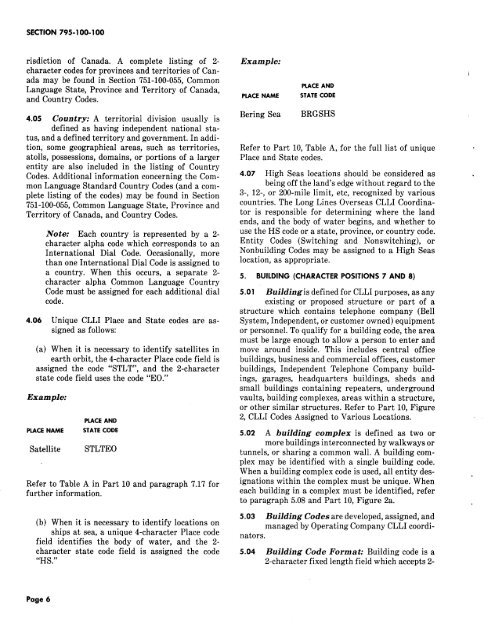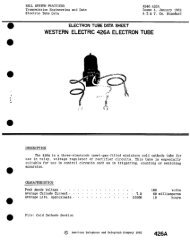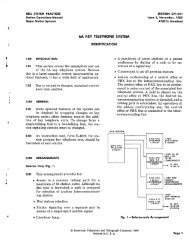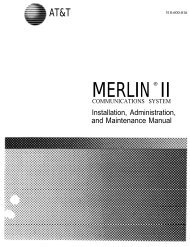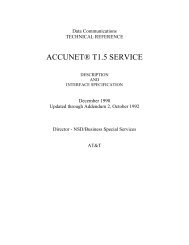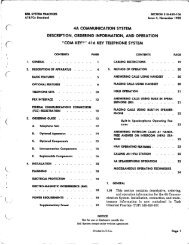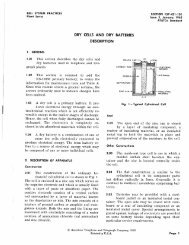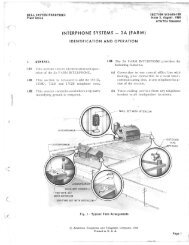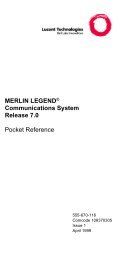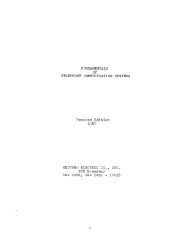COMMON LANGUAGE LOCATION IDENTIFICATION (CLLI) CODE ...
COMMON LANGUAGE LOCATION IDENTIFICATION (CLLI) CODE ...
COMMON LANGUAGE LOCATION IDENTIFICATION (CLLI) CODE ...
Create successful ePaper yourself
Turn your PDF publications into a flip-book with our unique Google optimized e-Paper software.
SECTION 795-1 00-100<br />
risdiction of Canada. A complete listing of 2character<br />
codes for provinces and territories of Can<br />
ada may be found in Section 751-100-055, Common<br />
Language State, Province and Territory of Canada,<br />
and Country Codes.<br />
4.05 Country: A territorial division usually is<br />
defined as having independent national status,<br />
and a defined territory and government. In addition,<br />
some geographical areas, such as territories,<br />
atolls, possessions, domains, or portions of a larger<br />
entity are also included in the listing of Country<br />
Codes. Additional information concerning the Common<br />
Language Standard Country Codes (and a complete<br />
listing of the codes) may be found in Section<br />
751-100-055, Common Language State, Province and<br />
Territory of Canada, and Country Codes.<br />
Note: Each country is represented by a 2-<br />
character alpha code which corresponds to an<br />
International Dial Code. Occasionally, more<br />
than one International Dial Code is assigned to<br />
a country. When this occurs, a separate 2-<br />
character alpha Common Language Country<br />
Code must be assigned for each additional dial<br />
code.<br />
4.06 Unique <strong>CLLI</strong> Place and State codes are as<br />
signed as follows:<br />
(a) When it is necessary to identify satellites in<br />
earth orbit, the 4-character Place code field is<br />
assigned the code "STLT", and the 2-character<br />
state code field uses the code "EO."<br />
Example:<br />
PLACE NAME<br />
Satellite<br />
PLACE AND<br />
STATE COOE<br />
STLTEO<br />
Refer to Table A in Part 10 and paragraph 7.17 for<br />
further information.<br />
(b) When it is necessary to identify locations on<br />
ships at sea, a unique 4-character Place code<br />
field identifies the body of water, and the 2character<br />
state code field is assigned the code<br />
"HS."<br />
Page 6<br />
Example:<br />
PLACE NAME<br />
Bering Sea<br />
PLACE AND<br />
STATE <strong>CODE</strong><br />
BRGSHS<br />
Refer to Part 10, Table A, for the full list of unique<br />
Place and State codes.<br />
4.07 High Seas locations should be considered as<br />
being off the land's edge without regard to the<br />
3-, 12-, or 200-mile limit, etc, recognized by various<br />
countries. The Long Lines Overseas <strong>CLLI</strong> Coordina<br />
tor is responsible for determining where the land<br />
ends, and the body of water begins, and whether to<br />
use the HS code or a state, province, or country code.<br />
Entity Codes (Switching and Nonswitching), or<br />
Nonbuilding Codes may be assigned to a High Seas<br />
location, as appropriate.<br />
5. BUILDING (CHARACTER POSITIONS 7 AND 8)<br />
5.01 Buildingis defined for <strong>CLLI</strong> purposes, as any<br />
existing or proposed structure or part of a<br />
structure which contains telephone company (Bell<br />
System, Independent, or customer owned) equipment<br />
or personnel. To qualify for a building code, the area<br />
must be large enough to allow a person to enter and<br />
move around inside. This includes central office<br />
buildings, business and commercial offices, customer<br />
buildings, Independent Telephone Company buildings,<br />
garages, headquarters buildings, sheds and<br />
small buildings containing repeaters, underground<br />
vaults, building complexes, areas within a structure,<br />
or other similar structures. Refer to Part 10, Figure<br />
2, <strong>CLLI</strong> Codes Assigned to Various Locations.<br />
5.02 A building complex is defined as two or<br />
more buildings interconnected by walkways or<br />
tunnels, or sharing a common wall. A building complex<br />
may be identified with a single building code.<br />
When a building complex code is used, all entity designations<br />
within the complex must be unique. When<br />
each building in a complex must be identified, refer<br />
to paragraph 5.08 and Part 10, Figure 2a.<br />
5.03 Building Codes are developed, assigned, and<br />
managed by Operating Company <strong>CLLI</strong> coordinators.<br />
5.04 Building Code Format: Building code is a<br />
2-character fixed length field which accepts 2-


